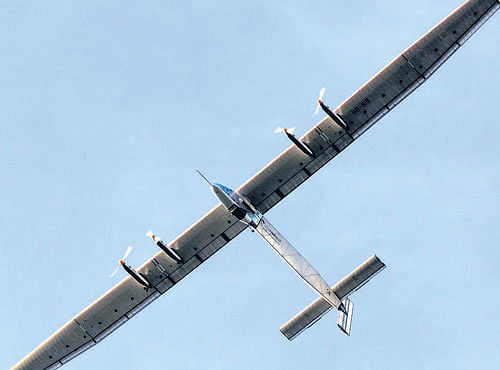
The Solar Impulse (Si2), the solar-powered aircraft on a mission to fly around the globe without a drop of fuel, left Mandalay in Myanmar for China on Sunday on the fifth leg of its journey.
The aircraft, piloted by the Swiss project chairman Bertrand Piccard, left Mandalay at 3.36 a.m. on Sunday, and is heading for Chongqing in China, according to a BBC report.
Leg five of the aircraft will be a long one -- about 1,375 km -- and is expected to take roughly 19 hours.
It will see the Si2 landing around midnight at the Chongqing Jiangbei International Airport.
The plan of the project team is to make a brief stop in Chongqing, and then try to reach Nanjing on the east coast of China.
This would set up the Si2 for the first of its big ocean crossings -- a five-day, five-night flight to Hawaii.
Capable of flying over oceans for several days and nights in a row, the single-seater Si2, which started its journey from Abu Dhabi in the United Arab Emirates (UAE) on March 9, will travel 35,000 km around the world in 25 days.
Mission control will not make a decision on the Nanjing leg until late on Monday.
The decision may rest on the state of the energy reserves held in the plane's batteries.
China's air traffic authorities would like the aircraft to start its sixth leg before dawn. However, if the reserves are marginal then the Si2 will be held in Chongqing until the batteries can be charged.
The problem with this scenario was that poor weather had been forecast in the Chongqing region in the coming days, and if the aircraft did not leave straightaway, it could be delayed for perhaps a week, reports said.
The project team expects the circumnavigation of the globe to be completed in a total of 12 legs, with a return to the UAE in a few months' time.
In the past month, the Si2 set two world records for manned solar-powered flight.
The first was for the longest distance covered on a single journey -- that of 1,468 km between Muscat in Oman and Ahmedabad in India.
The second was for a groundspeed of 117 knots (216 kmph), which was achieved during the flight from Varanasi in India to Mandalay.
The wingspan of the aircraft is 72 metres, which exceeds that of a 747 jumbo jet airliner. It, however, weighs only 2.3 tonnes, which is equivalent to that of a small car.
The light weight of the Si2 will be critical to its success over the coming months.
So too will the performance of the 17,000 solar cells that line the top of the aircraft's wings, and the energy-dense lithium-ion batteries that it will use to sustain night-time flying.
No solar-powered plane has ever flown around the world.
The Si2 venture is reminiscent of other great circumnavigation feats in the history of aviation, albeit fuelled ones.
In 1986, the Voyager aircraft became the first to fly around the world without stopping or refuelling. The propeller-driven vehicle took nine days to complete its journey.
Then, in 2005, the time set by Voyager was beaten by the Virgin Atlantic GlobalFlyer, a jet-powered plane, which completed its non-stop circumnavigation in just under three days.
The Si2 project aims to demonstrate the promise of clean energy.